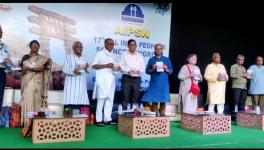COVID-19: Top Scientists Explain How India Can Tackle a Possible Third Wave
The possibility of a third wave of COVID-19 affecting India has invited several deliberations. A few days back a task force appointed by the Maharashtra government reportedly said that the third wave could affect the state within a month. Having said so, the task force emphasised that the ‘Delta Plus’ variant could drive such a wave.
However, in an India Today interview, one member from the task force stated that they had not said the third wave would hit within 2-4 weeks, rather they pointed out to the necessities of being prepared. Even Randeep Guleria, the director of All India Institute of Medical Sciences (AIIMS), warned that a third wave was inevitable and it could affect the country in the next six to eight weeks.
With the anticipation about a third wave and the horrific memories of the recent past still alive, there remains certain points to ponder upon.
What Can be Drivers of Third Wave?
Shahid Jameel, professor at Ashoka University and an eminent virologist, while speaking to Newsclick, pointed out three aspects. He said , “The timing and magnitude of the third wave would depend upon – 1) population that is still susceptible, i.e. unexposed or not vaccinated; 2) our behaviour as different parts of the country open up; 3) whether any more transmissible or ‘infectious’ variants emerge.”
“The first factor can be addressed by public policy of vaccinating at scale. The second will depend upon individual choices. And the third is beyond our control as mutations in viruses take place randomly. But even this can be controlled by reducing transmission and increased vaccination. Less transmission means less virus multiplication and less chances of random mutations. Increased vaccination will ensure that people have sufficient protection to reduce transmission,” Prof Jameel added.
Prof Gagandeep Kang of CMC Vellore, a leading vaccine specialist, also agreed to the points mentioned by Prof Jameel. “The drivers of a third wave will be the same as the drivers we have had previously. The variants are going to continue to be a concern. We need to understand that as long as there is replication of the virus the chance of mutations is high. While most mutations might not matter-- with a large number continuing to occur there will be some concern that could potentially fuel the third wave,” Prof Kang said.
“Despite the fact that a large proportion of our population has already been exposed to the virus, the sheer size of India means that we will continue to have a large number of unexposed and vulnerable people,” she cautioned.
However, Satyajit Rath, a noted immunologist and faculty at Pune’s Indian Institute of Science Education and Research, reiterated that an increase in outbreaks could not simply be visualised as smooth waves going up and down. “I think we are unlikely to be done with the epidemic yet, and that we are quite likely to see more outbreaks of varying severity. That said, I think that future outbreaks will be helped, like the ones so far, by growing lack of physical distancing in communities, helped along by complacency in messaging by government authorities. And, of course, more easily transmissible virus variants will certainly play a major role in these future outbreaks,” Prof Rath added.
Can India Meet the Benchmarks—Testing, Isolating, Sequencing?
Testing more number of people and isolating them promptly are the hallmarks in preventing the number of cases scaling up. Increased sequencing, on the other hand, will equip us in understanding how the virus is evolving. The question is whether India has advanced and improved in these strategies of mitigation.
On this point, Prof Jameel remarked saying, “It is hard to say how much testing is enough. India has deployed almost 400 million tests, which is second only to about 500 million tests by the USA. This is commendable for a country with our resources. But due to a very large population, at about 280,000 tests per million population, we lag behind many countries.” He added, “Our weak link has been insufficient testing in rural areas, which was perhaps not that critical in the first wave but became crucial in the second wave as the infection spread into the hinterland. We came up short.”
On the scale of sequencing, he said, “As for sequencing, for about 30 million confirmed cases, we have about 30,000 sequences from India – a rate of 0.1%. This is low, but at least double of what India did till December 2020. The overwhelming number of daily cases in the second wave has reduced this fraction.”
“Sequencing is done to know what is circulating in the population and what might emerge in the coming weeks. While our current sequencing rate will adequately address circulation, it will fall short of advance warning. However, even more important is how the sequencing information is taken for setting public health measures,” Prof Jameel added.
Prof Rath also agreed that the country lags behind on sequencing pretty badly. “India is certainly nowhere near the scale that would be desirable in terms of full-sequencing of the virus in samples for variant surveillance. While the numbers of sequenced samples are growing, they do not appear to be growing particularly rapidly,” he said.
“In addition, there does not seem to be sustained plans and strategies for 'readiness' for outbreaks over a long time to come, with regard to widespread decentralised critical care facilities and personnel, sustainable tactics , economic re-organisation in the times of physical distancing, a careful plan in the pipeline for virus variants, their implications and their inclusion in the next generation vaccine development processes.”
“And finally, it is not at all clear that there is, or is likely to be, equity between urban and rural India for the delivery of any of these interventions,” Rath added.
Prof Kang emphasised on the fact that India needed a relatively low positivity rate. On how testing helps in it, she explained,“As long as our testing manages to keep pace with the cases, we should be alright. We need to keep the cases at less than 5% and preferably less than 3% of all tests. At the moment, we are meeting that testing benchmark, but during the second wave we had breached it quite significantly and should have ramped up testing proportionately in order to be able to carry out tracing and isolating.”
“The tracing seems to have decreased over time and we need to ramp that up. Sequencing was pitched at about 5% of all positive cases over time. We were not able to meet that benchmark in the past but I hope we will in the future. Slowly, the numbers of samples being sequenced and the timeliness of reporting has increased. I hope this upward trajectory is maintained,” she said.
Containment Measures in Anticipation of Third Wave
Whether containment measures should be continued anticipating a third wave is a question of paramount importance. Physical distancing is a need to maintain control over the spread of the disease. But, closing the economy for too long a period is also a danger.
Prof Jameel pointed out the limitations of lockdowns in eliminating the disease and also suggested how a better way could be adopted. “Lockdowns do not work beyond a point and cause more harm to livelihoods and the economy. They delay but not eliminate transmission. A better approach is surveillance at scale and localised containments in areas showing increased spread. Such nuanced approaches would have to continue,” he said.
However, he hoped for a better situation in case of a large-scale outbreak in the future or a third wave of Covid-19. “We are unlikely to face situations analogous to the second wave for two reasons--firstly, the Centre and State governments will over prepare hospitals, oxygen, etc.; secondly, with wide spread of the virus in the second wave there are far fewer unexposed people; vaccination rates are also increasing, albeit slower than needed.” He said that unless a highly transmissible mutant of the virus emerges, the third wave, if it came at all, would likely be more reduced in magnitude. “The time to be careful is the festival season later in the year. When temperatures would drop, more people would be indoors and the mayhem of April and May would be a distant memory,” Prof Jameel said.
Prof Kang on this point said, “We need society to function, so restrictions in anticipation of a second wave need to be calibrated with appropriate triggers for increase or decrease of containment measures. Of course, the more vaccinated the society is, the fewer the restrictions need to be placed.”
Prof Rath, however, strictly said ‘no’ to the continuation of containment measures. According to him, that will simply prolong economic immiseration. “What is needed is to build active community participation to develop sustainable configurations for economic activities in these times, and commit real state resources to support informed and empowered communities to develop and execute their own approaches to maintaining distancing while carrying on economic activities,” he said.
Preparedness and Learning from Past
Learning from the devastating second wave is important for all of us. On whether we would see some discernible quick measures in the healthcare system and learning from the past as well, Prof Kang said, “Increasing surveillance not just for SARS-CoV2, but for respiratory symptoms and other diseases of concern is essential. Strengthening our primary health system so that care can be provided early and close to home must be the foundation of our healthcare.”
“On top of that, we need appropriate referral systems, so that people who need higher levels of care can get it easily and with minimal inconvenience. The public health system needs to be able to measure its performance and share that with the public--for whom it is meant. Data systems and data sharing are critical, and probably the most ignored component of health care in India,” she added.
Prof Rath pointed out some gaps and also some lessons to be learnt—“ Clearly, we have a major shortage of critical care medical resources as well as skilled personnel, particularly in rural India for the poor.”
“The enhancement-upgradation of these facilities in the public sector, in the primary health centre network, is an obvious lesson. The establishment of accessible testing centres, systems and facilities, especially for rural India, is another lesson. And again, community empowerment and active participation is an essential and largely missing cornerstone,” he said.
Prof Jameel suggested, “Good public health messaging, deployment of as much vaccination as possible, good sero-surveillance and sequencing, and using data to drive public health policy would all help. It would also help to have more hospital capacity and emergency supplies on standby.”
“But behaviour is going to be paramount. Each one of us can contribute by following Covid protocols,” he added.
Get the latest reports & analysis with people's perspective on Protests, movements & deep analytical videos, discussions of the current affairs in your Telegram app. Subscribe to NewsClick's Telegram channel & get Real-Time updates on stories, as they get published on our website.






















